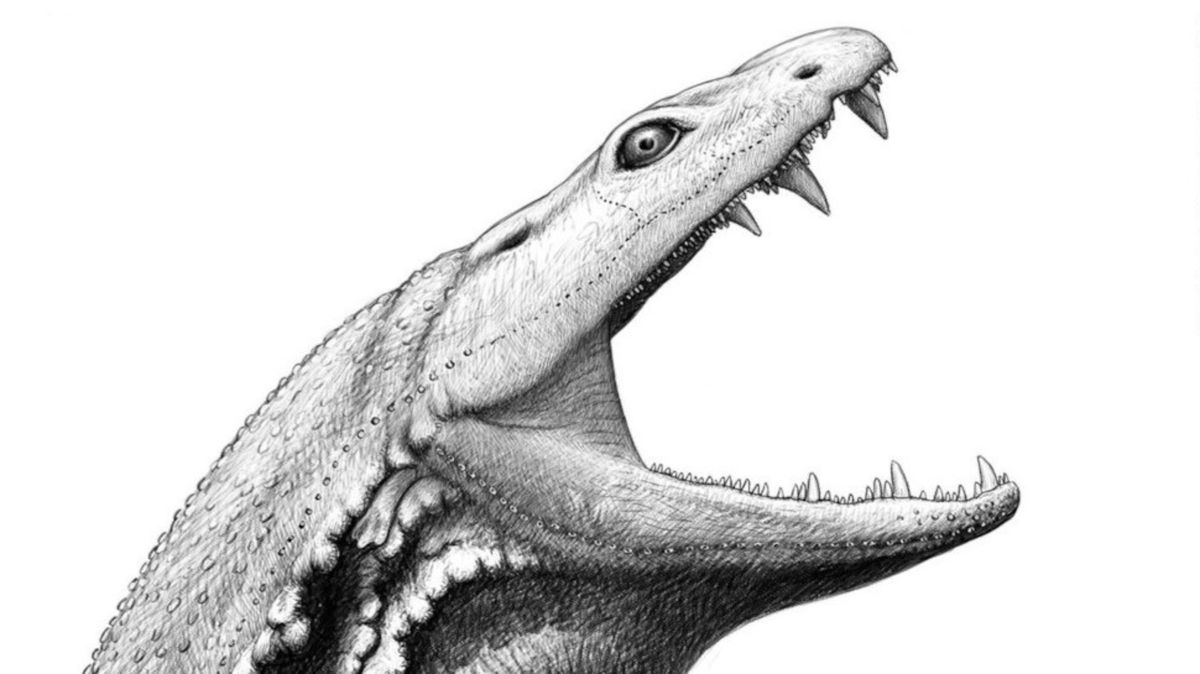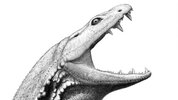By piecing together fragments of an ancient skull, scientists have reconstructed the haunting face of a 330 million-year-old crocodile-like "tadpole" creature, revealing not only what it looked like but also how it may have lived.
Scientists have known about the extinct species, Crassigyrinus scoticus, for a decade. But because all known fossils of the primordial carnivore are severely crushed, it has been difficult to find out more about it. Now, advances in computed tomography (CT) scanning and 3D visualization have allowed researchers to digitally piece the fragments back together for the first time, revealing more details about the ancient beast.
Previous research(opens in new tab) has shown that C. scoticus was a tetrapod, a four-limbed animal related to the first creatures to transition from water to land. Tetrapods began appearing on Earth around 400 million(opens in new tab) years ago, when the earliest tetrapods started evolving from lobe-finned fishes.
Unlike its relatives, however, past studies(opens in new tab) have found C. scoticus was an aquatic animal. This is either because its ancestors returned from land to the water, or because they never made it to land in the first place. Instead, it lived in coal swamps(opens in new tab) — wetlands which over millions of years would turn into coal stores — in what is now Scotland and parts of North America.
The new research, carried out by scientists at University College London, shows the animal had huge teeth and powerful jaws. Although its name means “thick tadpole,” the study shows C. scoticus had a relatively flat body and very short limbs, similar to a crocodile or alligator.
In life, Crassigyrinus would have been around two to three metres [6.5 to 9.8 feet] long, which was quite big for the time," lead study author Laura Porro(opens in new tab), a lecturer in cell and developmental biology at University College London, said in a statement(opens in new tab). "It would probably have behaved in a way similar to modern crocodiles, lurking below the surface of the water and using its powerful bite to grab prey."
C. scoticus was also adapted to hunt prey in swampy terrain. The new facial reconstruction shows it had large eyes to see in muddy water, as well as lateral lines, a sensory system that allows animals to detect vibrations in water.
Although much more is known about C. scoticus, scientists are still puzzled by a gap near the front of the animal’s snout. According to Porro, the gap may indicate that C. scoticus had other senses to help it hunt. It may have had a so-called rostral organ that helped the creature detect electric fields, Porro said. Alternatively, C. scoticus might have had a Jacobson's organ, which is found in animals such as snakes and helps to detect different chemicals.
"In life, Crassigyrinus would have been around two to three metres [6.5 to 9.8 feet] long, which was quite big for the time," lead study author Laura Porro(opens in new tab), a lecturer in cell and developmental biology at University College London, said in a statement(opens in new tab). "It would probably have behaved in a way similar to modern crocodiles, lurking below the surface of the water and using its powerful bite to grab prey."
C. scoticus was also adapted to hunt prey in swampy terrain. The new facial reconstruction shows it had large eyes to see in muddy water, as well as lateral lines, a sensory system that allows animals to detect vibrations in water.
A reconstruction of C. scoticus skull from crushed bone fragments. (Image credit: Porro et al)
Although much more is known about C. scoticus, scientists are still puzzled by a gap near the front of the animal’s snout. According to Porro, the gap may indicate that C. scoticus had other senses to help it hunt. It may have had a so-called rostral organ that helped the creature detect electric fields, Porro said. Alternatively, C. scoticus might have had a Jacobson's organ, which is found in animals such as snakes and helps to detect different chemicals.
In earlier studies, Porro said, scientists reconstructed C. scoticus with a very tall skull, similar to that of a Moray eel. "However, when I tried to mimic that shape with the digital surface from CT scans, it just didn't work," Porro explained. "There was no chance that an animal with such a wide palate and such a narrow skull roof could have had a head like that."
The new research, published May 2 in the Journal of Vertebrate Palaeontology(opens in new tab), shows the animal would have had a skull similar in shape to a modern crocodile's. To reconstruct what the animal looked like, the team used CT scans from four separate specimens and pieced the broken fossils together to reveal its face.
Once we had identified all of the bones, it was a bit like a 3D-jigsaw puzzle," Porro said. "I normally start with the remains of the braincase, because that's going to be the core of the skull, and then assemble the palate around it."
The team now plans to carry out biomechanical simulations to test out their ideas about C. scoticus and its capabilities.



 www.livescience.com
www.livescience.com
Scientists have known about the extinct species, Crassigyrinus scoticus, for a decade. But because all known fossils of the primordial carnivore are severely crushed, it has been difficult to find out more about it. Now, advances in computed tomography (CT) scanning and 3D visualization have allowed researchers to digitally piece the fragments back together for the first time, revealing more details about the ancient beast.
Previous research(opens in new tab) has shown that C. scoticus was a tetrapod, a four-limbed animal related to the first creatures to transition from water to land. Tetrapods began appearing on Earth around 400 million(opens in new tab) years ago, when the earliest tetrapods started evolving from lobe-finned fishes.
Unlike its relatives, however, past studies(opens in new tab) have found C. scoticus was an aquatic animal. This is either because its ancestors returned from land to the water, or because they never made it to land in the first place. Instead, it lived in coal swamps(opens in new tab) — wetlands which over millions of years would turn into coal stores — in what is now Scotland and parts of North America.
The new research, carried out by scientists at University College London, shows the animal had huge teeth and powerful jaws. Although its name means “thick tadpole,” the study shows C. scoticus had a relatively flat body and very short limbs, similar to a crocodile or alligator.
In life, Crassigyrinus would have been around two to three metres [6.5 to 9.8 feet] long, which was quite big for the time," lead study author Laura Porro(opens in new tab), a lecturer in cell and developmental biology at University College London, said in a statement(opens in new tab). "It would probably have behaved in a way similar to modern crocodiles, lurking below the surface of the water and using its powerful bite to grab prey."
C. scoticus was also adapted to hunt prey in swampy terrain. The new facial reconstruction shows it had large eyes to see in muddy water, as well as lateral lines, a sensory system that allows animals to detect vibrations in water.
Although much more is known about C. scoticus, scientists are still puzzled by a gap near the front of the animal’s snout. According to Porro, the gap may indicate that C. scoticus had other senses to help it hunt. It may have had a so-called rostral organ that helped the creature detect electric fields, Porro said. Alternatively, C. scoticus might have had a Jacobson's organ, which is found in animals such as snakes and helps to detect different chemicals.
"In life, Crassigyrinus would have been around two to three metres [6.5 to 9.8 feet] long, which was quite big for the time," lead study author Laura Porro(opens in new tab), a lecturer in cell and developmental biology at University College London, said in a statement(opens in new tab). "It would probably have behaved in a way similar to modern crocodiles, lurking below the surface of the water and using its powerful bite to grab prey."
C. scoticus was also adapted to hunt prey in swampy terrain. The new facial reconstruction shows it had large eyes to see in muddy water, as well as lateral lines, a sensory system that allows animals to detect vibrations in water.
A reconstruction of C. scoticus skull from crushed bone fragments. (Image credit: Porro et al)
Although much more is known about C. scoticus, scientists are still puzzled by a gap near the front of the animal’s snout. According to Porro, the gap may indicate that C. scoticus had other senses to help it hunt. It may have had a so-called rostral organ that helped the creature detect electric fields, Porro said. Alternatively, C. scoticus might have had a Jacobson's organ, which is found in animals such as snakes and helps to detect different chemicals.
In earlier studies, Porro said, scientists reconstructed C. scoticus with a very tall skull, similar to that of a Moray eel. "However, when I tried to mimic that shape with the digital surface from CT scans, it just didn't work," Porro explained. "There was no chance that an animal with such a wide palate and such a narrow skull roof could have had a head like that."
The new research, published May 2 in the Journal of Vertebrate Palaeontology(opens in new tab), shows the animal would have had a skull similar in shape to a modern crocodile's. To reconstruct what the animal looked like, the team used CT scans from four separate specimens and pieced the broken fossils together to reveal its face.
Once we had identified all of the bones, it was a bit like a 3D-jigsaw puzzle," Porro said. "I normally start with the remains of the braincase, because that's going to be the core of the skull, and then assemble the palate around it."
The team now plans to carry out biomechanical simulations to test out their ideas about C. scoticus and its capabilities.

Scientists reveal face of 10-foot 'killer tadpole' that terrorized Earth long before the dinosaurs
With huge teeth and large eyes, Crassigyrinus scoticus was specially adapted to hunt in the coal swamps of Scotland and North America.


